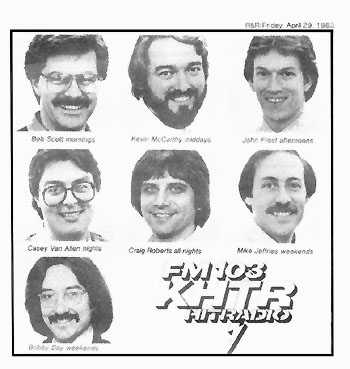|
|
| knew that we were dropping KMOX-FM for
KHTR, and it didn't make sense to spend a ton on old calls. We finished number two
in the market as KMOX-FM, and became an even stronger number two as KHTR." He elaborated on what the station did during the winter book. "Heavy TV, outdoor and print media in January. We lightened up in February, and then heavied up at the beginning of March toward the end of this sweep, going into the spring book. We have an average of 400 GRP's of TV time a week and periodically will drop back to a maintenance schedule during the Spring book." What he's describing is similar to a "pulse" advertising plan, which gives TV viewers the impression that the advertisement is still being seen even in a week where it doesn't appear. "Yes, we play black crossovers . . . We're not afraid of black music as long as it has a pop feel to it." |
KHTR's Hit Music Mix To get a better idea of the formatics of KKHR, I asked Ed for some percentages in his music categories. He told me that in a typical hour the station is 70% current, 20 % recurrent, and 10 % oldies. Heavy rotations move every two or two and half hours, mediums every four hours or so, and lights every five or six. Recurrents turn twice a day and oldies once every couple of days. "We'd rather play a killer oldie than fill in with fluff. KHTR uses the RCS Selector System, which helps to rotate things so that our cume doesn't burn. It can make invisible to habit listeners." Since the area of recurrents can be pretty nebulous, I asked Ed for his definition. "I call a recurrent any record that won't die. For example, some songs have just fallen off the chart but have a great deal of airplay left. And there others like Joan Jett's 'I Love Rock N Roll' that still are incredibly strong for us." Almost No Dayparting This brought me to the subject of dayparting, or lack of dayparting in this case. Ed's thinking is reminiscent of the early Top 40 philosophy on this issue. "Joan Jett gets played 24 hours a day. There is very light dayparting, with few exceptions. My reasoning is that if I like it at 7pm, won't I like it at 6am? I think we (as an industry) started looking over our shoulder and second guessing ourselves too much," he reflected. Most programmers might ask, "Can an adult take this record?" Ed responded, "My primary concern is that the station sounds consistent in the morning, afternoon, and at night. If we aren't, then the people that tune in for one thing will hear something they're not expecting in another daypart and we'll end up satisfying very few in the long run." With that, I asked Ed for a description of the station and its texture. "I would describe it as a pop-AOR as opposed to a pop-A/C. We do lean to the harder side of things, as we consider our competition to be AOR (KSHE and KWK). KHTR avoids the softer things like Stephen Bishop, the new Toto, or the Ronnie Milsap. We will be early on a record like the Tubes or a Night Ranger-type of song. As a result we are sharing with KSHE, KWK, and KY98. Although the Midwest tends to be slow on black crossovers, Ed's attitude is more positive. "Yes, we play black crossovers. We'll play the Dazz Band, Irene Cara, Lionel Richie, and Michael Jackson. We're not afraid of black music as long as it has a pop feel to it." |
Ed added,
"At the same time I think that our 'Quick Cash' contest was instrumental in helping
things along. KHTR gave away $20,000 in January using our 'phrase that pays' contest. We
wanted to get our 'Hit Radio' image across, and we also wanted to develop some
brand-loyalty to the station. The simplest way to do that was to give the impression that
the audience owned us. So we used the phrase 'KHTR Is My Hit Radio.' All they had to do
was be the designated caller to win the cash." The simple idea for the contest came
out of focus group research conducted by KHTR. |
|
